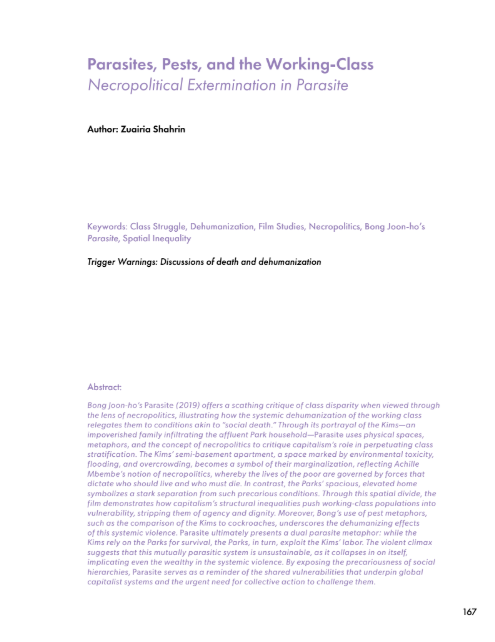Parasites, Pests, and the Working-Class
Necropolitical Extermination in Parasite
DOI:
https://doi.org/10.29173/crossings312Keywords:
Class Struggle, Dehumanization, Film Studies, Necropolitics, Bong Joon-ho’s Parasite, Spatial InequalityAbstract
Bong Joon-ho’s Parasite (2019) offers a scathing critique of class disparity when viewed through the lens of necropolitics, illustrating how the systemic dehumanization of the working class relegates them to conditions akin to “social death.” Through its portrayal of the Kims—an impoverished family infiltrating the affluent Park household—Parasite uses physical spaces, metaphors, and the concept of necropolitics to critique capitalism’s role in perpetuating class stratification. The Kims’ semi-basement apartment, a space marked by environmental toxicity, flooding, and overcrowding, becomes a symbol of their marginalization, reflecting Achille Mbembe’s notion of necropolitics, whereby the lives of the poor are governed by forces that dictate who should live and who must die. In contrast, the Parks’ spacious, elevated home symbolizes a stark separation from such precarious conditions. Through this spatial divide, the film demonstrates how capitalism’s structural inequalities push working-class populations into vulnerability, stripping them of agency and dignity. Moreover, Bong’s use of pest metaphors, such as the comparison of the Kims to cockroaches, underscores the dehumanizing effects of this systemic violence. Parasite ultimately presents a dual parasite metaphor: while the Kims rely on the Parks for survival, the Parks, in turn, exploit the Kims’ labor. The violent climax suggests that this mutually parasitic system is unsustainable, as it collapses in on itself, implicating even the wealthy in the systemic violence. By exposing the precariousness of social hierarchies, Parasite serves as a reminder of the shared vulnerabilities that underpin global capitalist systems and the urgent need for collective action to challenge them.

Downloads
Published
Issue
Section
License
Copyright (c) 2025 Zuairia Shahrin

This work is licensed under a Creative Commons Attribution 4.0 International License.

